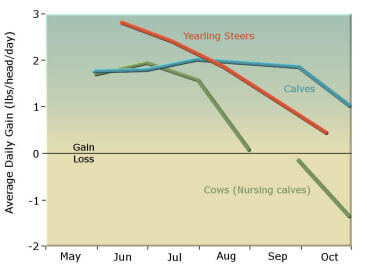Forage Quality and Livestock Performance
Performance of livestock is a function of nutrient requirements and intake. The quantity and quality of available forage are the primary regulators of nutrient intake in grazing cattle. Animal performance will decline whenever remaining forage falls below a minimum level.
 Seasonal patterns in average daily gain of different classes of livestock during the summer grazing season over a 15 year time period in north central Colorado (Klipple and Costello 1960)
Seasonal patterns in average daily gain of different classes of livestock during the summer grazing season over a 15 year time period in north central Colorado (Klipple and Costello 1960)
Even when drought does not occur, animal performance declines as the summer grazing season progresses (see figure at right). These seasonal declines correspond to advancing plant maturity. When drought occurs, calf gain during late summer may be entirely from the "back fat of the cow."
If plant growth is stopped by drought, forage quality may decline rapidly because livestock selectively graze the highest quality forage first. The rate of decline in forage quantity and quality during drought is much more pronounced than in an average growing season.
Drought often reduces the number of days during which green forage is available to livestock. However, forage that cures at early stages of plant development can provide higher than average quality during mid and late summer. Ranchers who adequately reduce stocking rates to account for reduced quantities of forage under drought conditions often experience above average animal performance.
Conception and Lactation
Nutritional deficiencies also have an adverse effect on conception rates, especially if cows are thin at calving. Conception rates will first decline in lactating first-calf heifers because they still need nutrients for growth, in contrast to mature cows.
Lactation increases cow nutrient requirements substantially. Continued nursing further delays a cow's return to estrus when nutritional deficiencies occur. Early weaning of calves may be the most efficient management practice available for maintaining reproductive performance when nutritional stress occurs.